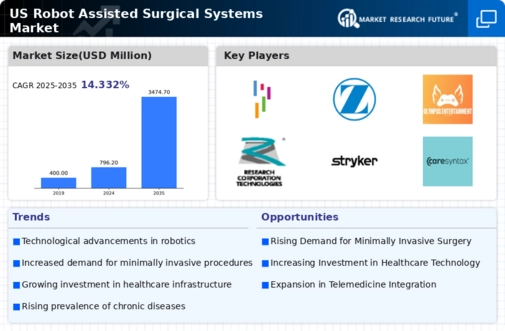Supportive Reimbursement Policies
Supportive reimbursement policies are emerging as a significant driver for the robot assisted-surgical-systems market. As insurance companies increasingly recognize the value of robotic-assisted surgeries, they are expanding coverage for these procedures. This shift is crucial, as financial considerations often dictate the adoption of new technologies in healthcare. Recent data indicates that hospitals with favorable reimbursement rates for robotic surgeries experience a 30% higher adoption rate of robotic systems. Consequently, the robot assisted-surgical-systems market is likely to see accelerated growth as more healthcare providers are incentivized to invest in these advanced surgical technologies.
Surgeon Training and Skill Enhancement
The emphasis on advanced training for surgeons is significantly impacting the robot assisted-surgical-systems market. As surgical techniques evolve, there is a growing need for specialized training programs that focus on robotic systems. Institutions are increasingly investing in simulation-based training to enhance the skills of surgeons, which in turn drives the adoption of robotic systems. Reports indicate that hospitals that implement comprehensive training programs see a 20% increase in the utilization of robotic systems. This focus on skill enhancement not only improves surgical outcomes but also fosters greater confidence among surgeons, thereby propelling the growth of the robot assisted-surgical-systems market.
Increased Investment in Healthcare Technology
The surge in investment in healthcare technology is a crucial driver for the robot assisted-surgical-systems market. With healthcare expenditures in the US projected to reach $4 trillion by 2025, a significant portion is being allocated to innovative surgical technologies. This influx of capital enables hospitals and surgical centers to acquire advanced robotic systems, which are essential for modern surgical practices. Furthermore, the robot assisted-surgical-systems market is likely to benefit from partnerships between technology firms and healthcare providers, aimed at developing cutting-edge solutions that enhance surgical efficiency and patient outcomes.
Growing Awareness of Surgical Robotics Benefits
The increasing awareness among patients and healthcare professionals regarding the benefits of robotic-assisted surgeries is driving the robot assisted-surgical-systems market. Educational campaigns and patient testimonials highlight advantages such as shorter hospital stays and quicker recovery times. As a result, more patients are advocating for robotic options during consultations, influencing surgeons to adopt these technologies. Market analysis suggests that patient demand for robotic surgeries has risen by approximately 25% in recent years, indicating a shift in patient preferences that is likely to continue shaping the landscape of the robot assisted-surgical-systems market.
Rising Demand for Minimally Invasive Procedures
The increasing preference for minimally invasive surgical techniques is a primary driver of the robot assisted-surgical-systems market. Patients are increasingly seeking procedures that promise reduced recovery times, minimized scarring, and lower risk of complications. According to recent data, minimally invasive surgeries have seen a growth rate of approximately 15% annually in the US. This trend is likely to continue as healthcare providers adopt robotic systems that enhance precision and control during surgeries. The robot assisted-surgical-systems market is thus positioned to benefit from this shift, as these systems are specifically designed to facilitate such procedures, making them more appealing to both surgeons and patients alike.

















Leave a Comment